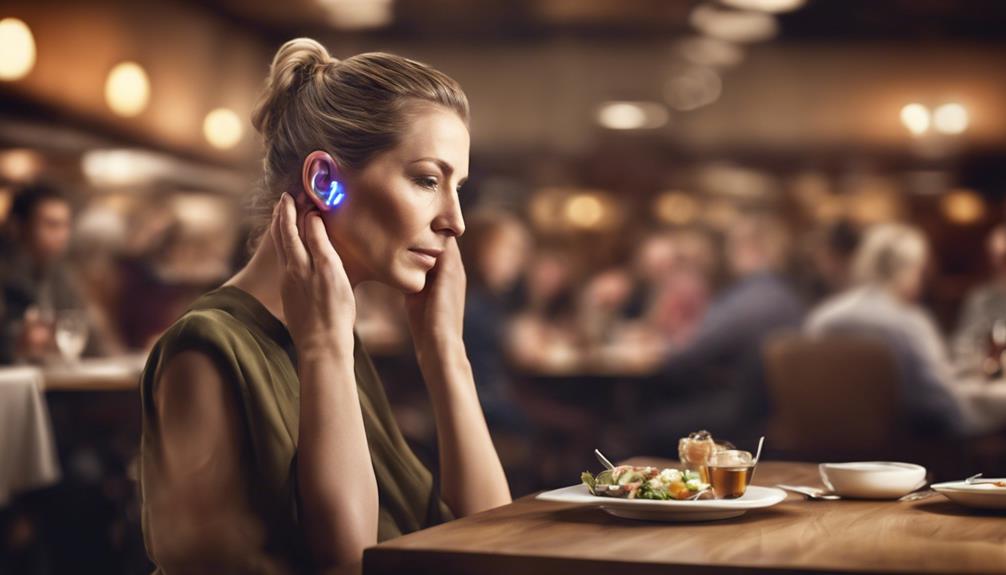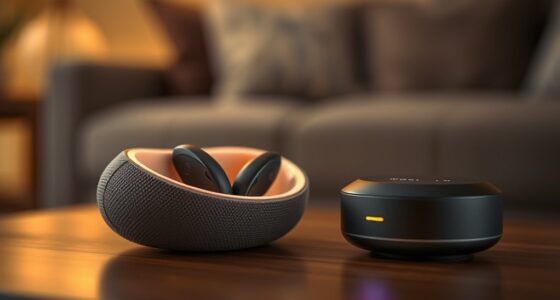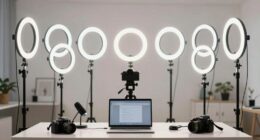Exploring the range of hearing aids for individuals with hearing impairment showcases a variety of innovative devices waiting to be explored. From personal amplifiers that enhance sounds like a magnifying glass enlarges images, to loop systems that enhance clarity in conversations, the top 10 devices offer a well-coordinated array aimed at enhancing daily communication.
But what lies beyond these familiar names and functionalities? Join us as we uncover the hidden gems within this realm of assistive technology, where new horizons and possibilities unfold with each device on the list.
Key Takeaways
- Personal amplifiers enhance sound clarity and reduce background noise discreetly.
- Hearing loop systems transmit sound directly to hearing aids in theaters and churches.
- Captioned telephones offer real-time captions and adjustable features for phone conversations.
- Smartphone technology provides clear sound transmission and compatibility with hearing aids for improved communication.
Personal Amplifiers
Personal amplifiers are portable devices that enhance sounds for individuals with hearing loss, offering improved speech clarity and reduced background noise in various settings. These devices are essential for individuals who struggle to hear in environments with competing noises. Personal amplifiers can be discreetly used in classrooms, meetings, or during one-on-one conversations, providing a personalized listening experience.
One of the key advantages of personal amplifiers is their ability to reduce background noise, making it easier for individuals with hearing loss to focus on the speaker's voice. By enhancing sounds, these devices ensure that important information isn't missed during conversations or presentations. Additionally, some personal amplifiers come equipped with adjustable volume controls and different listening modes, allowing users to customize their listening experience based on their preferences.
Loop Systems

Loop systems, utilizing electromagnetic energy to transmit sound directly to receivers in hearing aids or cochlear implants, are integral tools in enhancing auditory experiences for individuals with hearing loss. Telecoils, commonly integrated into hearing aids, receive signals from loop systems, significantly improving sound clarity for users. These systems are prevalent in various settings such as theaters, churches, and auditoriums, where background noise can often hinder hearing.
Captioned Telephones
Captioned telephones revolutionize communication for individuals with hearing loss by providing real-time captions during phone conversations, enhancing accessibility and facilitating effective engagement in verbal interactions.
These specialized phones are designed to assist those with hearing difficulties by displaying a transcript of the conversation in real-time. Captioned telephones offer various features such as volume control, adjustable ringers, and amplified handsets to cater to the specific needs of users with hearing loss.
One popular brand, CapTel, even provides these phones at no cost with professional approval, making them more accessible to those in need.
Hearing Aid Compatible Phones

Hearing aid compatible phones are designed with specific features like telecoils and compatibility with hearing aid streaming technology to ensure clear sound transmission and reduced interference. These phones undergo testing and rating processes to guarantee their compatibility with hearing aids.
Many leading smartphone manufacturers offer a variety of models tailored to meet the needs of individuals with hearing loss.
Phone Compatibility Guide
When exploring phone compatibility for hearing aid users, it's essential to consider the seamless integration of features that enhance communication. Hearing aid compatible phones offer various features to support individuals with hearing aids during phone calls. Here is a guide to phone compatibility for hearing aid users:
- Hearing Aid Mode: Allows users to optimize settings for their hearing aids.
- Telecoil Mode: Enables clear sound transmission directly to the hearing aid.
- T-coil Support: Ensures compatibility with hearing aids equipped with T-coils.
- Adjustable Volume and Clarity Settings: Some phones offer customization options for volume and clarity to meet individual needs.
Choosing a phone with these features can greatly improve the communication experience for individuals with hearing aids.
Best Brands Listed
Among the top brands recognized for producing hearing aid compatible phones are Apple, Samsung, Google, and LG, known for their commitment to enhancing accessibility and communication for individuals with hearing loss. These brands prioritize features like telecoil support, M4/T4 ratings, and TTY mode in their devices to ensure seamless compatibility with hearing aids.
Apple's iPhones, Samsung's Galaxy series, Google's Pixel phones, and LG's smartphones often come with advanced settings that allow users to customize their hearing aid experience. By offering M4/T4 ratings, these companies demonstrate their dedication to reducing interference and improving sound quality for users with hearing aids. Choosing a phone from these reputable brands can significantly enhance the communication and accessibility for individuals with hearing loss.
Vibrating Alarm Clocks

Vibrating alarm clocks offer customizable vibration patterns, multiple alarm settings, and a portable, discreet design. These features cater to the diverse needs of individuals with hearing loss, ensuring they wake up on time with personalized alerts.
The convenience and effectiveness of vibrating alarm clocks make them essential tools for enhancing the daily routines of individuals with hearing difficulties.
Customizable Vibration Patterns
How can customizable vibration patterns in alarm clocks benefit individuals with hearing loss?
Customizable vibration patterns in vibrating alarm clocks are incredibly advantageous for individuals with hearing loss. Here's why:
- Personalized Wake-Up Experience: Users can set vibration patterns based on their preferences, ensuring a personalized wake-up experience.
- Effective Waking Up: Vibrating alarm clocks use vibrations instead of sound alerts, making waking up effective for individuals with hearing difficulties.
- Timely Awakening: Customizable vibrations help individuals with hearing loss wake up on time without relying on audible alarms.
- Discreet and Efficient: Vibrating alarm clocks provide a discreet and efficient way for deaf individuals to start their day without disturbing others.
Multiple Alarm Settings
Utilizing multiple alarm settings on vibrating alarm clocks allows individuals with hearing loss to customize their wake-up schedule for optimal daily planning and routine management. Vibrating alarm clocks, designed with bright lights and reliable alerts, cater specifically to deaf individuals, providing a practical solution for those who may not hear traditional alarm sounds. Brands like Sonic Alert offer popular models such as the Sonic Bomb, ensuring timely alerts for waking up. These clocks not only enhance daily routines but also promote independence and punctuality for individuals with hearing difficulties. The customizable alarm settings on vibrating clocks empower users to set multiple alarms according to their unique schedules, offering a personalized approach to starting the day on time.
| Features | Benefits |
|---|---|
| Bright Lights | Enhanced visibility |
| Reliable Alerts | Dependable wake-up calls |
| Multiple Alarm Settings | Customizable schedules |
| Designed for Deaf Individuals | Specific needs catered to |
Portable and Discreet
Portable and discreet vibrating alarm clocks offer a convenient solution for individuals with hearing loss, providing effective wake-up alerts without disrupting others nearby. These devices are designed to be easily carried and used without drawing attention, making them ideal for various settings.
Here are some key points to consider about portable and discreet vibrating alarm clocks:
- Effective Wake-Up Solution: Vibrating alarm clocks use vibrations instead of sound to wake up users, ensuring timely alerts without the need for audible alarms.
- Ideal for Hearing Loss: These clocks are particularly suitable for individuals with hearing loss who may not respond to traditional alarm sounds.
- Non-Disruptive: The discreet nature of these devices allows for personal wake-up calls without disturbing roommates or family members.
- Features for Accessibility: Brands like Sonic Alert offer vibrating alarm clocks with bright lights and strong vibrations for effective wake-up calls.
TV Listening Systems

TV listening systems revolutionize home entertainment by wirelessly transmitting amplified audio from the television directly to the headset using radio frequency technology. These systems employ transmitter boxes that send audio signals wirelessly to the headset, allowing for personalized sound levels tailored to the individual's needs. By providing amplified audio, TV listening systems ensure a comfortable TV watching experience without disturbing others in the vicinity.
Ideal for individuals with hearing loss, TV listening systems offer a solution for enhanced sound clarity while enjoying television programs. The direct transmission of sound to the headset guarantees that users can adjust the volume to a level that suits their hearing requirements, enabling clear understanding without raising the overall TV volume.
FM Systems

FM systems, utilizing radio waves to transmit sound directly to hearing aids or receivers, are commonly employed in educational and professional settings such as classrooms, lecture halls, and meetings to enhance speech understanding. These systems offer significant benefits for individuals with hearing loss in various listening environments.
Here are some key points about FM systems:
- Improved Speech Clarity: FM systems can reduce background noise and amplify the speaker's voice, leading to better speech clarity for the user.
- Portability: FM systems are portable devices that can be easily carried or worn by the user, providing convenience and flexibility in different settings.
- Versatility: These systems are versatile and can be used in a range of environments, from classrooms to conferences, making them a valuable tool for individuals with hearing impairments.
- Enhanced Learning and Communication: By enhancing speech understanding, FM systems help individuals better engage in conversations, follow lectures, and participate actively in various activities.
Infrared Listening Systems

Infrared listening systems function by using light signals to send audio directly to receivers, a technology that proves beneficial for those with hearing impairments.
The advantages of infrared technology include delivering clear sound devoid of interference or background noise, enhancing the auditory experience for individuals with hearing loss.
These systems ensure secure and private audio transmission, making them ideal for confidential settings like theaters, classrooms, and conference rooms.
How Infrared Systems Work
In venues like theaters and classrooms, a technology utilizing invisible light waves to transmit audio signals wirelessly is employed to enhance sound for individuals with hearing impairments. Infrared systems operate by converting sound into light signals, which are then received by devices worn by users, ensuring clear sound transmission free from interference. The technology limits signal reception to the line of sight within a specific area, guaranteeing secure communication. These systems offer a wide range that can be adjusted to cover different room sizes, making them versatile solutions for various listening environments.
- Infrared systems use invisible light waves.
- Sound is converted into light signals.
- Signal reception is limited to line of sight.
- Systems offer a wide range of coverage.
Benefits of Infrared Technology
Utilizing advanced technology, these systems enhance auditory experiences for individuals facing hearing challenges by wirelessly transmitting sound signals using infrared light. Infrared listening systems offer superior sound quality, ensuring clear audio even in environments with background noise or distance obstacles. The technology provides enhanced privacy as the infrared signals are confined within a specific area, preventing sound leakage to neighboring spaces. Moreover, the interference-free transmission characteristic of infrared technology guarantees a seamless listening experience for individuals with hearing loss. These systems are particularly beneficial in large areas like classrooms, theaters, and conference rooms, where users can enjoy improved sound clarity and confidentiality without external disturbances.
| Benefits of Infrared Technology | |
|---|---|
| Sound Quality | Clear and crisp audio |
| Privacy | Confined sound transmission |
| Interference-free Transmission | Seamless listening experience |
Bluetooth Streamers

Bluetooth streamers seamlessly connect hearing aids to Bluetooth-enabled devices, allowing deaf individuals to enjoy direct audio streaming for enhanced communication and convenience. These devices play a crucial role in aiding individuals with hearing impairments. Here are some key points about Bluetooth streamers:
- Wireless Connectivity: Bluetooth streamers are small devices that create a wireless connection between hearing aids and Bluetooth-enabled gadgets, facilitating seamless audio streaming.
- Enhanced Communication: They enable users to stream phone calls, music, and other audio content directly to their hearing aids, enhancing communication experiences.
- Reduced Background Noise: Bluetooth streamers help reduce background noise, ensuring that users receive clearer audio signals and improved sound quality.
- Compatibility and Convenience: These devices are compatible with various hearing aid models, offering convenience in daily activities and aiding in better hearing experiences, especially in noisy environments or during phone calls.
Smartphone Apps

Smartphone apps revolutionize communication accessibility for deaf individuals by providing live captioning and captioned calls, bridging gaps in interaction and fostering inclusivity.
Apps like Ava and Rogervoice are at the forefront of this revolution, offering real-time captioning and captioned calls to facilitate seamless conversations for the deaf community. Ava app utilizes advanced technology to provide instant captions, ensuring that individuals with hearing challenges can actively participate in discussions.
On the other hand, Rogervoice specializes in captioned calls, enabling deaf individuals to engage in phone conversations with ease. These apps not only enhance communication accessibility but also promote independence and inclusivity for deaf individuals.
Frequently Asked Questions
What Are the 5 Assistive Devices for the Deaf?
We can explore five essential assistive devices for the deaf. These include:
- Neckloops for wireless Bluetooth connectivity.
- Signaling systems for event alerts.
- The TED Program providing adaptive telephone devices.
- Livescribe Pens for note digitization.
- Captioned phones with talk-to-text features.
Each of these tools serves a unique purpose in enhancing communication and accessibility for individuals with hearing loss.
What Is the Most Commonly Used Assistive Listening Device?
The most commonly used assistive listening device is the hearing loop system. It utilizes electromagnetic energy to transmit sound straight to receivers, improving clarity.
Telecoils, found in many hearing aids, pick up signals from hearing loops for enhanced sound quality. These systems are prevalent in public spaces like theaters and churches, helping individuals with hearing loss.
The popularity of hearing loop systems is increasing to provide better accessibility for those with hearing impairments.
What Are AAC Devices for Deaf People?
AAC devices for deaf individuals, like speech-generating devices, aid in communication by translating words or symbols into speech. These devices offer customizable voice options, making communication more effective.
Text displays and word prediction software on AAC devices help individuals input information quickly, benefiting those with communication difficulties. AAC devices can be tailored based on various factors to suit the specific needs of individuals with speech or language disorders.
What Are 3 Devices Deaf People Use Around the House?
Around the house, deaf individuals commonly use visual alert signalers for devices like doorbells and phones. These signalers provide notifications through flashing lights, alerting us to incoming calls or visitors.
Portable vibrating pagers are also essential, ensuring parents are promptly notified when their baby cries. Plus, clocks and alarms with visual or vibrating cues help us wake up in the morning.
These devices enhance our safety and awareness at home.
Conclusion
In conclusion, these top 10 assistive listening devices for deaf individuals offer a wide range of innovative solutions to enhance communication and accessibility. From personal amplifiers to smartphone apps, there's a device to suit every need.
But have you considered how these devices not only improve quality of life, but also empower individuals to fully engage in the world around them?











